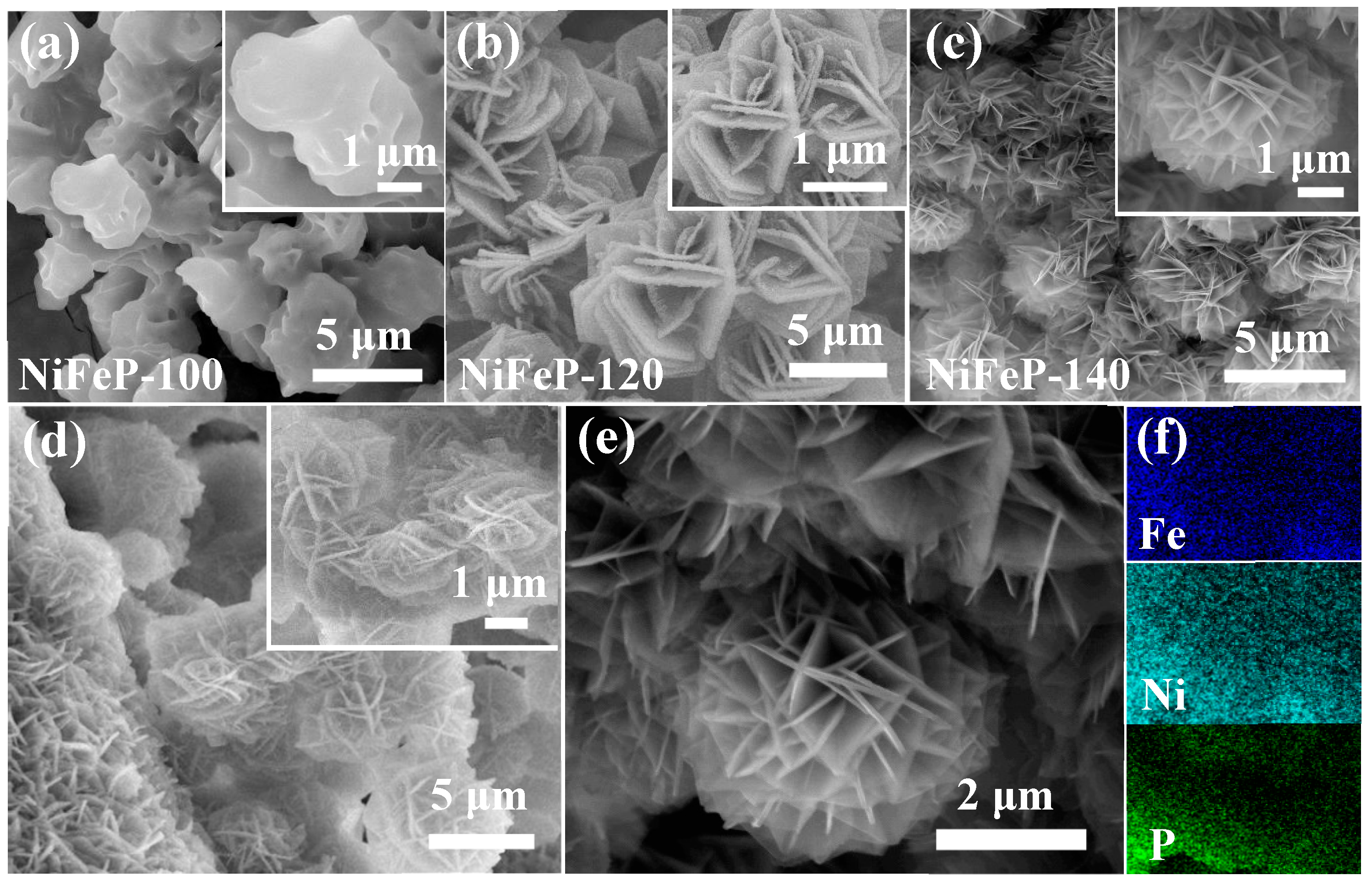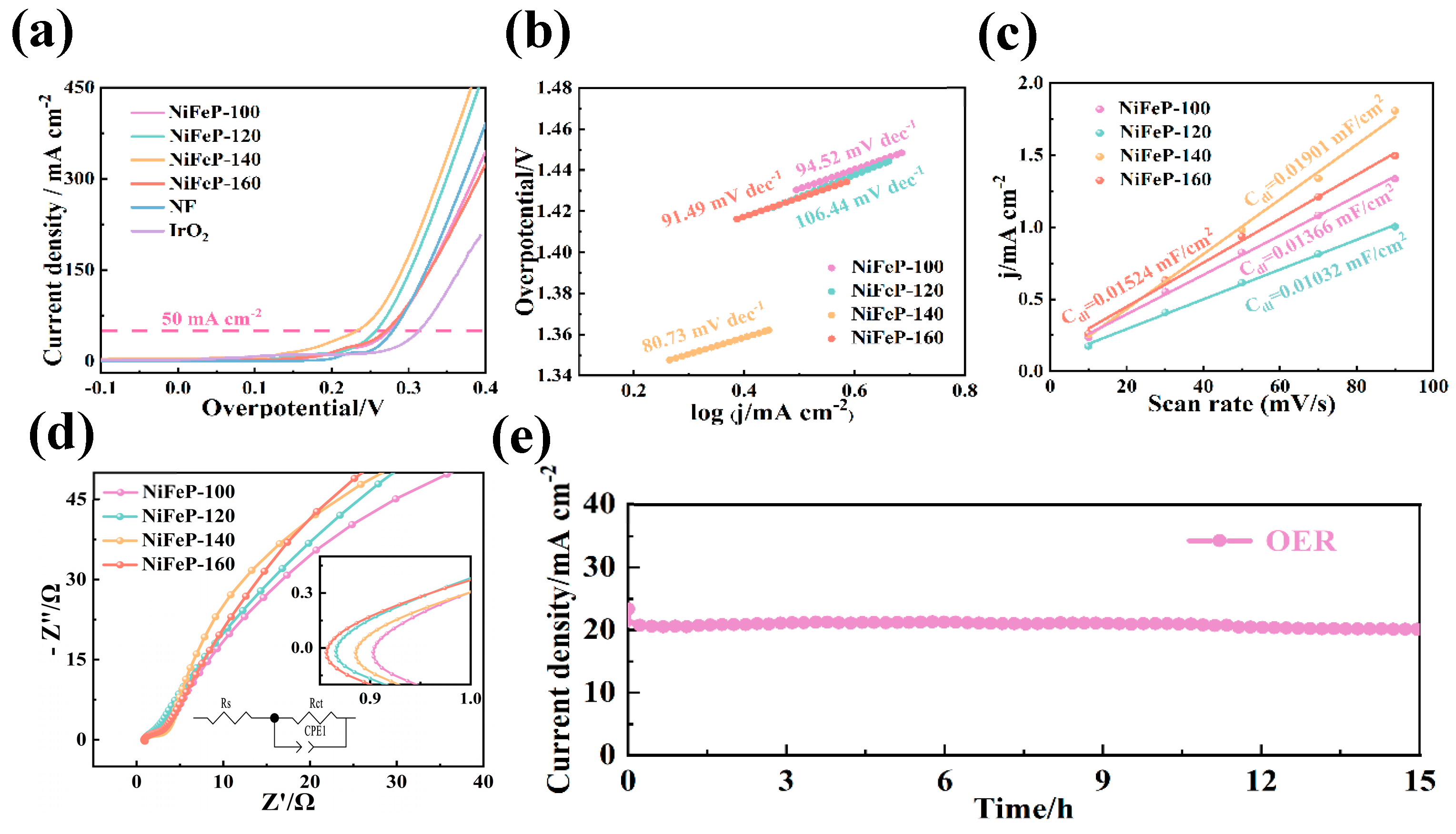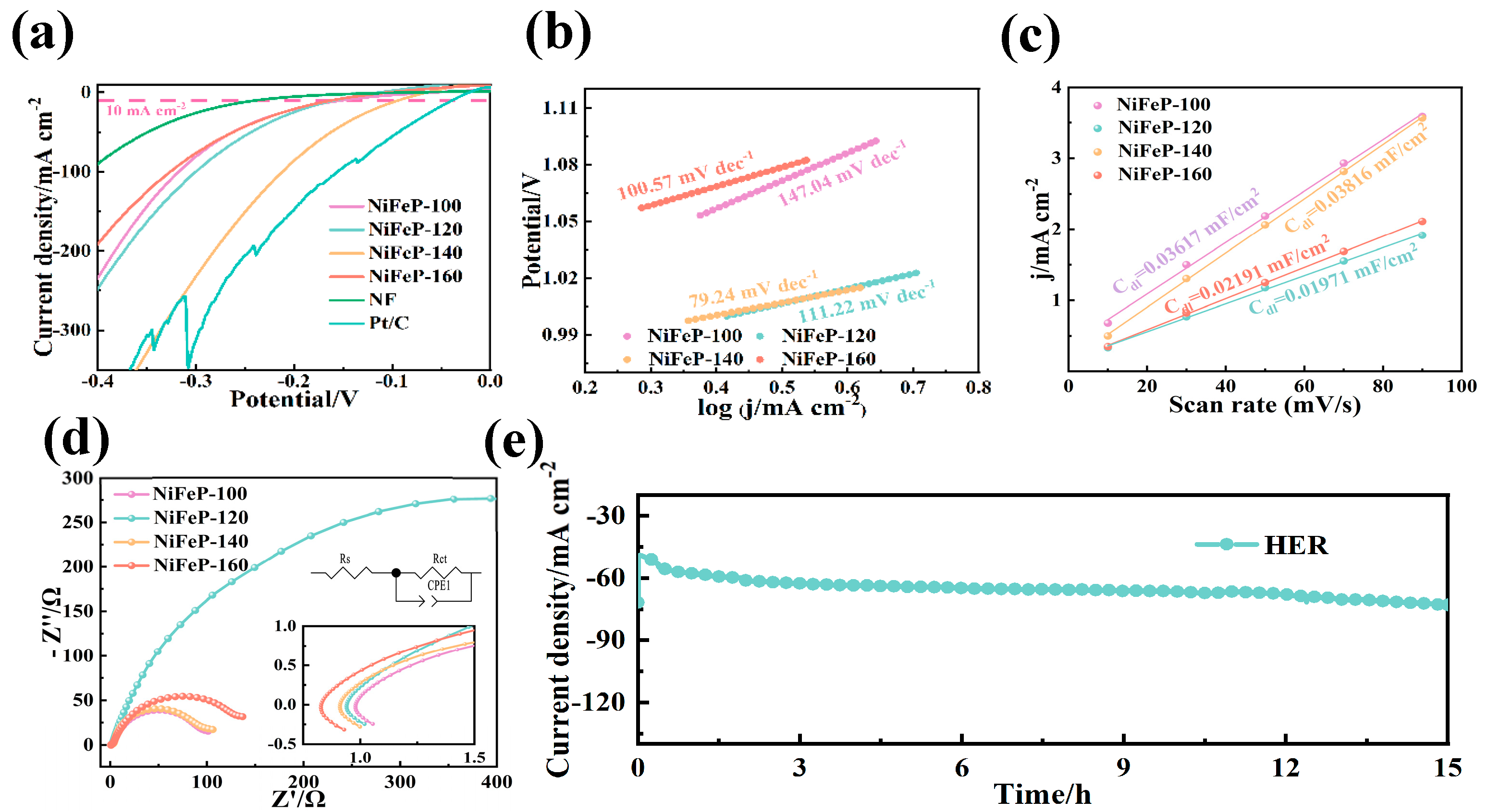NiFeP Microsphere Electrocatalyst for High-Efficiency Electrolysis of Water
Abstract
1. Introduction
2. Results and Discussion
3. Experimental Section
3.1. Materials
3.2. Preparation of NiFeP Catalysts
3.3. Structural Characterization
3.4. Electrochemical Characterization
4. Conclusions
Author Contributions
Funding
Data Availability Statement
Conflicts of Interest
References
- Lin, Y.; Wang, H.; Peng, C.K.; Bu, L.; Chiang, C.L.; Tian, K.; Zhao, Y.; Zhao, J.; Lin, Y.G.; Lee, J.M.; et al. Co-induced electronic optimization of hierarchical NiFe LDH for oxygen evolution. Small 2020, 16, 2002426. [Google Scholar] [CrossRef] [PubMed]
- Du, Y.; Li, Z.; Liu, Y.; Yang, Y.; Wang, L. Nickel-iron phosphides nanorods derived from bimetallic-organic frameworks for hydrogen evolution reaction. Appl. Surf. Sci. 2018, 457, 1081–1086. [Google Scholar] [CrossRef]
- Liu, Y.; Wu, X. Metal-organic framework assisted design of ZnVOx cathode for aqueous zinc batteries at extreme work condition. Nano Energy 2024, 127, 109809. [Google Scholar] [CrossRef]
- Zhao, D.; Dai, M.; Liu, H.; Zhu, X.; Wu, X. PPy film anchored on ZnCo2O4 nanowires facilitating efficient bifunctional electrocatalysis. Mater. Today Energy 2021, 20, 100637. [Google Scholar] [CrossRef]
- Liu, Z.; Li, S.; Wang, F.; Li, M.; Ni, Y. Hierarchically porous FeNi3@FeNi layered double hydroxide nanostructures: One-step fast electrodeposition and highly efficient electrocatalytic performances for overall water splitting. Dalton Trans. 2021, 50, 6306–6314. [Google Scholar] [CrossRef]
- Ahmed, K.W.; Fowler, M. Performance evaluation and durability analysis of NiFeCoOx catalysts for alkaline water electrolysis in anion exchange membrane electrolyzers. Catalysts 2024, 14, 322. [Google Scholar] [CrossRef]
- Sun, T.; Wang, J.; Qiu, C.; Ling, X.; Tian, B.; Chen, W.; Su, C. B, N codoped and defect-rich nanocarbon material as a metal-free bifunctional electrocatalyst for oxygen reduction and evolution reactions. Adv. Sci. 2018, 5, 1800036. [Google Scholar] [CrossRef]
- Anantharaj, S.; Kundu, S.; Noda, S. “The Fe Effect”: A review unveiling the critical roles of Fe in enhancing OER activity of Ni and Co based catalysts. Nano Energy 2021, 80, 105514. [Google Scholar] [CrossRef]
- Zhang, J.Z.; Zhang, Z.; Zhang, H.B.; Mei, Y.; Zhang, F.; Hou, P.X.; Liu, C.; Cheng, H.M.; Li, J.C. Prussian-blue-analogue-derived ultrathin Co2P-Fe2P nanosheets for universal-pH overall water splitting. Nano Lett. 2023, 23, 8331–8338. [Google Scholar] [CrossRef]
- Lyons, M.E.G.; Floquet, S. Mechanism of oxygen reactions at porous oxide electrodes. Part 2–oxygen evolution at RuO2, IrO2 and IrxRu1−xO2 electrodes in aqueous acid and alkaline solution. Phys. Chem. Chem. Phys. 2011, 13, 5314–5335. [Google Scholar] [CrossRef]
- Wu, L.; Ning, M.; Xing, X.; Wang, Y.; Zhang, F.; Gao, G.; Song, S.; Wang, D.; Yuan, C.; Yu, L.; et al. Boosting oxygen evolution reaction of (Fe,Ni)OOH via defect engineering for anion exchange membrane water electrolysis under industrial conditions. Adv. Mater. 2023, 35, e2306097. [Google Scholar] [CrossRef] [PubMed]
- Wang, M.; Liu, X.; Wu, X. Realizing efficient electrochemical overall water electrolysis through hierarchical CoP@NiCo-LDH nanohybrids. Nano Energy 2023, 114, 108681. [Google Scholar] [CrossRef]
- Zhao, D.; Liu, X.; Zhang, W.c.; Wu, X.; Cho, Y.R. Highly efficient and stable Mo-CoP3@FeOOH electrocatalysts for alkaline seawater splitting. Small Methods 2024, 8, 2301474. [Google Scholar] [CrossRef] [PubMed]
- Zhao, D.; Dai, M.; Liu, H.; Duan, Z.; Tan, X.; Wu, X. Bifunctional ZnCo2S4@CoZn13 hybrid electrocatalysts for high efficient overall water splitting. J. Energy Chem. 2022, 69, 292–300. [Google Scholar] [CrossRef]
- Wang, L.; Wang, P.; Xue, X.; Wang, D.; Shang, H.; Zhao, Y.; Zhang, B. Interface engineering of three-phase nickel–cobalt sulfide/nickel phosphide/iron phosphide heterostructure for enhanced water splitting and urea electrolysis. J. Colloid Interface Sci. 2024, 665, 88–99. [Google Scholar] [CrossRef] [PubMed]
- Chen, G.; Wang, T.; Zhang, J.; Liu, P.; Sun, H.; Zhuang, X.; Chen, M.; Feng, X. Accelerated hydrogen evolution kinetics on NiFe-layered double hydroxide electrocatalysts by tailoring water dissociation active sites. Adv. Mater. 2018, 30, 1706279. [Google Scholar] [CrossRef] [PubMed]
- Wang, M.; Liu, X.; Sun, Y.; Wu, X. High-efficiency NiCo layered double hydroxide electrocatalyst. New J. Chem. 2022, 46, 18535–18542. [Google Scholar] [CrossRef]
- Duan, Z.; Zhao, D.; Sun, Y.; Tan, X.; Wu, X. Bifunctional Fe-doped CoP@Ni2P heteroarchitectures for high-efficient water electrocatalysis. Nano Res. 2022, 15, 8865–8871. [Google Scholar] [CrossRef]
- Zhang, P.; Lu, X.F.; Nai, J.; Zang, S.Q.; Lou, X.W. Construction of hierarchical Co-Fe oxyphosphide microtubes for electrocatalytic overall water splitting. Adv. Sci. 2019, 6, 1900576. [Google Scholar] [CrossRef]
- Teng, X.; Wang, Z.; Wu, Y.; Zhang, Y.; Yuan, B.; Xu, Y.; Wang, R.; Shan, A. Enhanced alkaline hydrogen evolution reaction of MoO2/Ni3S2 nanorod arrays by interface engineering. Nano Energy 2024, 122, 109299. [Google Scholar] [CrossRef]
- Liao, Y.; He, R.; Pan, W.; Li, Y.; Wang, Y.; Li, J.; Li, Y. Lattice distortion induced Ce-doped NiFe-LDH for efficient oxygen evolution. Chem. Eng. J. 2023, 464, 142669. [Google Scholar] [CrossRef]
- Zhang, Y.; Cheng, C.-Q.; Kuai, C.-G.; Sokaras, D.; Zheng, X.-L.; Sainio, S.; Lin, F.; Dong, C.-K.; Nordlund, D.; Du, X.-W. Unveiling the critical role of the Mn dopant in a NiFe(OH)2 catalyst for water oxidation. J. Mater. Chem. A 2020, 8, 17471–17476. [Google Scholar] [CrossRef]
- Tang, Y.; Liu, Q.; Dong, L.; Wu, H.B.; Yu, X.-Y. Activating the hydrogen evolution and overall water splitting performance of NiFe LDH by cation doping and plasma reduction. Appl. Catal. B-Environ. 2020, 266, 118627. [Google Scholar] [CrossRef]
- Zong, Q.; Tao, D.; Yang, H.; Zhan, J.; Liu, X.; Wang, J.; Zhang, Q.; Cao, G. Optimizing nanostructure and constructing heterostructure via Mo/W incorporation to improve electrochemical properties of NiCoP for hybrid supercapacitors. Sci. China-Mater. 2022, 65, 1195–1206. [Google Scholar] [CrossRef]
- Yu, W.; Li, Q.; Xiao, W.; Wang, J.; Dong, B.; Chai, Y.; Wu, Z.; Wang, L. Unique CoP microflower decorated with phosphorous-enriched PtP2 onto nickel foam with interfacial electronic interactions to boost alkaline water-splitting. Adv. Funct. Mater. 2024, 34, 2313935. [Google Scholar] [CrossRef]
- Yang, W.; Du, X.; Zhao, J.; Chen, Z.; Li, J.; Xie, J.; Zhang, Y.; Cui, Z.; Kong, Q.; Zhao, Z.; et al. Hydrated eutectic electrolytes with ligand-oriented solvation shells for long-cycling zinc-organic batteries. Joule 2020, 4, 1557–1574. [Google Scholar] [CrossRef]
- Hu, F.; Zhang, Y.; Shen, X.; Tao, J.; Yang, X.; Xiong, Y.; Peng, Z. Porous amorphous NiFeOx /NiFeP framework with dual electrocatalytic functions for water electrolysis. J. Power Sources 2019, 428, 76–81. [Google Scholar] [CrossRef]
- Chen, W.; Chang, S.; Yu, H.; Li, W.; Zhang, H.; Zhang, Z. FeNiP nanoparticle/N, P dual-doped carbon composite as a trifunctional catalyst towards high-performance zinc–air batteries and overall water electrolysis. Nanoscale 2021, 13, 17136–17146. [Google Scholar] [CrossRef] [PubMed]
- Yang, B.; Bin, D.; Tamirat, A.G.; Liu, Y.; Liu, L.; Liu, B. Bamboo-like nitrogen-doped carbon nanotubes encapsulated with NiFeP nanoparticles and their efficient catalysis in the oxygen evolution reaction. Electrochim. Acta 2020, 331, 135360. [Google Scholar] [CrossRef]
- Wang, D.; Umar, A.; Wu, X. Enhanced water electrolysis performance of bifunctional NiCoP electrocatalyst in alkaline media. J. Electroanal. Chem. 2023, 950, 117888. [Google Scholar] [CrossRef]
- Wang, D.; Huai, X.; Abdukader, A.; Umar, A.; Wu, X. Highly active and durable NiCoP electrocatalyst through Ga ion intercalation strategy for long-lasting water electrolysis. Appl. Surf. Sci 2014, 660, 159972. [Google Scholar] [CrossRef]
- Zhai, Y.; Ren, X.; Sun, Y.; Li, D.; Wang, B.; Liu, S. Synergistic effect of multiple vacancies to induce lattice oxygen redox in NiFe-layered double hydroxide OER catalysts. Appl. Catal. B-Environ. 2023, 323, 122091. [Google Scholar] [CrossRef]
- Xu, Z.; Ying, Y.; Zhang, G.; Li, K.; Liu, Y.; Fu, N.; Guo, X.; Yu, F.; Huang, H. Engineering NiFe layered double hydroxide by valence control and intermediate stabilization toward the oxygen evolution reaction. J. Mater. Chem. A 2020, 8, 26130–26138. [Google Scholar] [CrossRef]
- Dong, G.; Chen, T.; Xie, F.; Xue, D.; Liu, T.; Chen, L.; Xia, J.; Du, S.; Wang, F.; Xie, F.; et al. NiFeP composites supported on Ni foam as an efficient and robust bifunctional electrocatalyst for overall water splitting in alkaline solution. J. Alloys Compd. 2023, 968, 171746. [Google Scholar] [CrossRef]
- Zhao, H.; Wang, Y.; Wang, Y.; Cao, T.; Zhao, G. Electro-fenton oxidation of pesticides with a novel Fe3O4@Fe2O3/activated carbon aerogel cathode: High activity, wide pH range and catalytic mechanism. Appl. Catal. B-Environ. 2012, 125, 120–127. [Google Scholar] [CrossRef]
- Li, Z.; Yao, Y.; Sun, S.; Liang, J.; Hong, S.; Zhang, H.; Yang, C.; Zhang, X.; Cai, Z.; Li, J.; et al. Carbon oxyanion self-transformation on NiFe oxalates enables long-term ampere-level current density seawater oxidation. Angew. Chem.-Int. Edit. 2023, 63, 2316522. [Google Scholar]
- Yue, C.Z.; Zhang, X.N.; Yin, J.; Zhou, H.W.; Liu, K.; Liu, X. Highly efficient FeS2@FeOOH core-shell water oxidation electrocatalyst formed by surface reconstruction of FeS2 microspheres supported on Ni foam. Appl. Catal. B-Environ. 2023, 339, 123171. [Google Scholar] [CrossRef]
- Guo, B.; Yu, K.; Li, H.; Song, H.; Zhang, Y.; Lei, X.; Fu, H.; Tan, Y.; Zhu, Z. Hollow structured micro/nano MoS2 spheres for high electrocatalytic activity hydrogen evolution reaction. ACS Appl. Mater. Interfaces 2016, 8, 5517–5525. [Google Scholar] [CrossRef] [PubMed]
- Zhao, P.; Fu, S.; Luo, Y.; Peng, C.; Cheng, L.; Jiao, Z. Deciphering the space charge effect of the CoNiLDH/FeOOH n–n heterojunction for efficient electrocatalytic oxygen evolution. Small 2023, 19, 2305241. [Google Scholar] [CrossRef]
- Liu, X.P.; Gong, M.X.; Deng, S.F.; Zhao, T.H.; Shen, T.; Zhang, J.; Wang, D.L. Transforming damage into benefit: Corrosion engineering enabled electrocatalysts for water splitting. Adv. Funct. Mater. 2021, 31, 2009032. [Google Scholar] [CrossRef]
- Jiang, M.; Zhai, H.; Chen, L.; Mei, L.; Tan, P.; Yang, K.; Pan, J. Unraveling the synergistic mechanism of bi-functional nickel–iron phosphides catalysts for overall water splitting. Adv. Funct. Mater. 2023, 33, 2302621. [Google Scholar] [CrossRef]
- Wang, M.; Liu, X.; Liu, H.; Zhao, D.; Wu, X. NiCo layered double hydroxide nanosheets with enhanced electrochemical performance. J. Alloys Compd. 2022, 903, 163926. [Google Scholar] [CrossRef]
- Guler, A.C.; Antos, J.; Masar, M.; Michal, U.; Michal, M.; Ivo, K. Comprehensive evaluation of photoelectrochemical performance dependence on geometric features of ZnO nanorod electrodes. Nanoscale Adv. 2023, 11, 3091–3103. [Google Scholar] [CrossRef]
- Huang, L.; Yao, R.; Wang, X.; Sun, S.; Zhu, X.; Liu, X.; Kim, M.G.; Lian, J.; Liu, F.; Li, Y.; et al. In situ phosphating of Zn-doped bimetallic skeletons as a versatile electrocatalyst for water splitting. Energy Environ. Sci. 2022, 15, 2425–2434. [Google Scholar] [CrossRef]
- Xin, X.; Zheng, L.; Ying, X.; Yang, Y.W. IrMo nanocluster-doped porous carbon electrocatalysts derived from cucurbituril boost efficient alkaline hydrogen evolution. J. Am. Ceram. Soc. 2023, 145, 16548–16556. [Google Scholar]
- Liang, Q.; Brocks, G.; Bieberle-Hütter, A. Oxygen evolution reaction (OER) mechanism under alkaline and acidic conditions. J. Phys. A Energy 2021, 3, 026001. [Google Scholar] [CrossRef]
- Duan, Z.; Liu, H.; Tan, X.; Umar, A.; Wu, X. Bifunctional CoP electrocatalysts for overall water splitting. Catal. Commun. 2022, 162, 106379. [Google Scholar] [CrossRef]





| Material | Rs | Rct |
|---|---|---|
| NiFeP-100 | 0.88 Ω | 4.01 Ω |
| NiFeP-120 | 0.85 Ω | 4.87 Ω |
| NiFeP-140 | 0.88 Ω | 2.27 Ω |
| NiFeP-160 | 0.84 Ω | 3.35 Ω |
| Materials | Rs | Rct |
|---|---|---|
| NiFeP-100 | 0.91 Ω | 2.87 Ω |
| NiFeP-120 | 0.923 Ω | 4.86 Ω |
| NiFeP-140 | 0.91 Ω | 2.43 Ω |
| NiFeP-160 | 0.81 Ω | 3.55 Ω |
Disclaimer/Publisher’s Note: The statements, opinions and data contained in all publications are solely those of the individual author(s) and contributor(s) and not of MDPI and/or the editor(s). MDPI and/or the editor(s) disclaim responsibility for any injury to people or property resulting from any ideas, methods, instructions or products referred to in the content. |
© 2024 by the authors. Licensee MDPI, Basel, Switzerland. This article is an open access article distributed under the terms and conditions of the Creative Commons Attribution (CC BY) license (https://creativecommons.org/licenses/by/4.0/).
Share and Cite
Li, D.; Wu, X. NiFeP Microsphere Electrocatalyst for High-Efficiency Electrolysis of Water. Catalysts 2024, 14, 485. https://doi.org/10.3390/catal14080485
Li D, Wu X. NiFeP Microsphere Electrocatalyst for High-Efficiency Electrolysis of Water. Catalysts. 2024; 14(8):485. https://doi.org/10.3390/catal14080485
Chicago/Turabian StyleLi, Ding, and Xiang Wu. 2024. "NiFeP Microsphere Electrocatalyst for High-Efficiency Electrolysis of Water" Catalysts 14, no. 8: 485. https://doi.org/10.3390/catal14080485
APA StyleLi, D., & Wu, X. (2024). NiFeP Microsphere Electrocatalyst for High-Efficiency Electrolysis of Water. Catalysts, 14(8), 485. https://doi.org/10.3390/catal14080485







